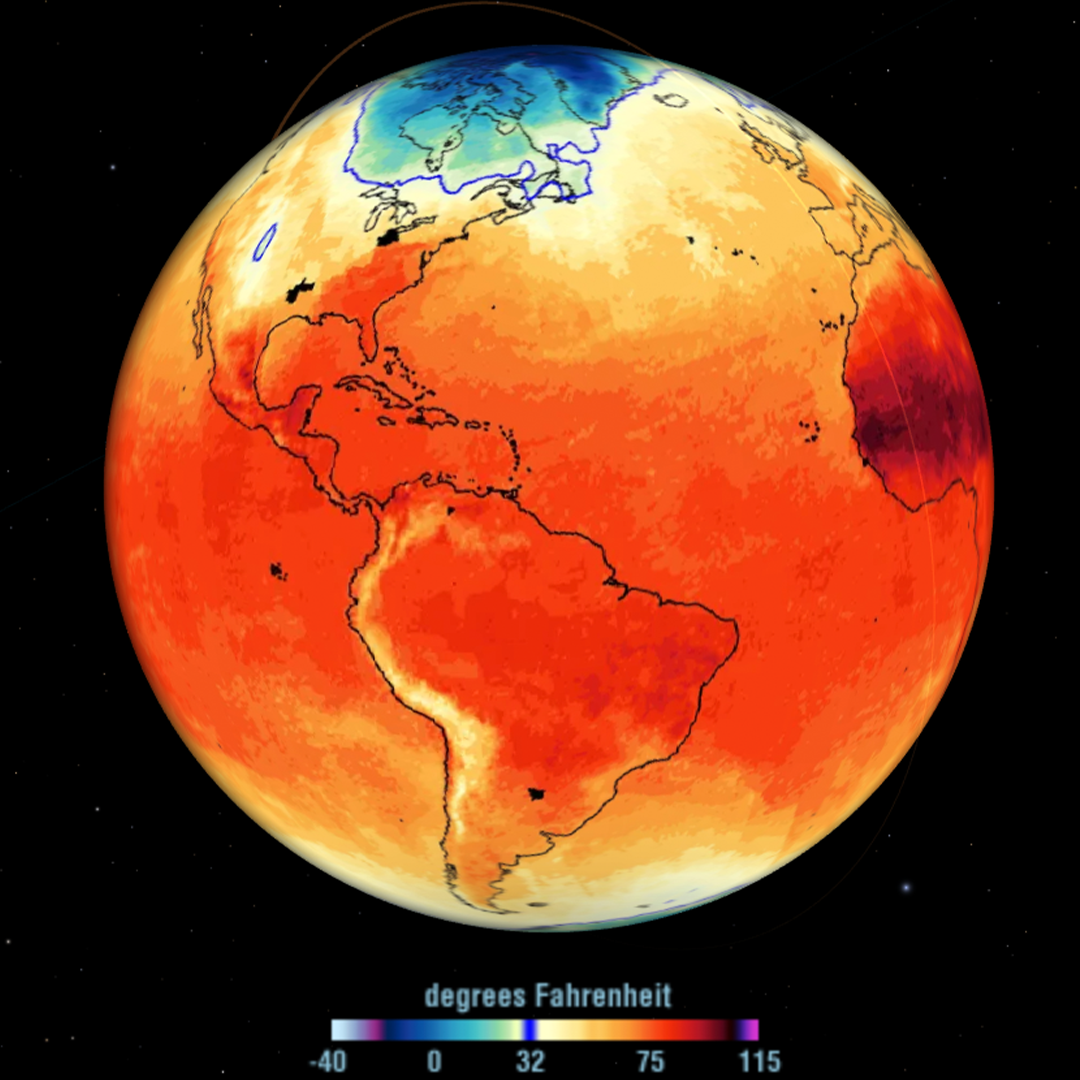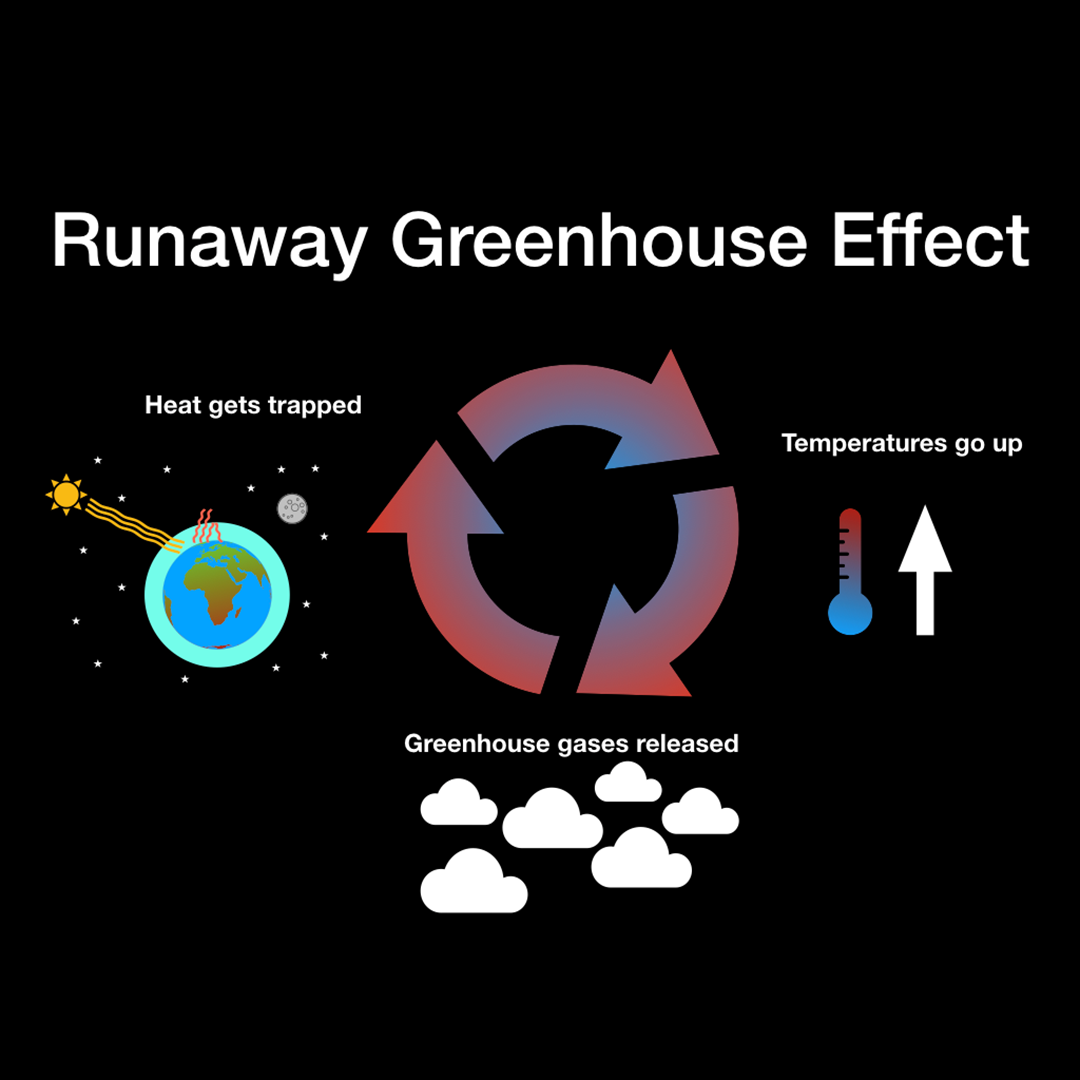How Astronomy Helps Us Understand Climate Change

Header Image: Visualization depicting a global view of the Earth’s average air temperature on April 3–7, 2025. Purple and blue areas depict cooler temperatures while red and orange depict hotter temperatures. Image courtesy of NASA’s Eyes on Earth.
As one of the world’s premiere planetariums, people expect us to talk about stars, the Big Bang, the Moon landing, and other space science topics. So folks may be a bit surprised that the Adler also talk about Earthly-matters, like climate change.
Astronomy studies patterns and behaviors of planets, whether it is a gas giant, like Jupiter, or a water world in the goldilocks zone, like Earth. Astronomy is a useful tool for studying Earth as it provides a zoomed-out, macroscopic view of the planet. It gives us a larger scale to make sense of its changes and the implications of what happens on it; for example, global climate change.
From a macro level, global climate change is one of the largest issues confronting planet Earth today. Did you know that Earth is not the only planet that deals with climate change? In fact, climate change is a natural phenomenon that planets past, present, and future face.
Greenhouse Atmospheres
Many planets—including Earth, Venus, and Mars—have greenhouse atmospheres. Greenhouse atmospheres are composed of gases that trap heat, called greenhouse gases. One very common greenhouse gas that you’ve probably heard of is carbon dioxide (CO2).
How Greenhouse Gases Work
To explain how greenhouse gases work, let’s use Earth as an example. When the Sun’s light shines onto Earth, the visible light moves through the atmosphere with ease. When the visible light hits the ground, its energy converts to heat. The warmed ground then re-emits the energy as infrared light. Unlike visible light, infrared light cannot move through the atmosphere as easily, as some of it gets absorbed by greenhouse gases. This traps the heat inside the atmosphere and warms the Earth’s surface even more. This is known as the greenhouse effect.
While every planet’s atmosphere is different, one thing remains consistent: the more greenhouse gases, the more a planet’s surface heats up.
The greenhouse effect is an important and special feature of certain atmospheres, as it controls a planet’s surface temperature. It’s precisely what allows Earth to stay warm enough for life to thrive!
Venus’s Runaway Greenhouse Effect

Venus is a planet that was once incredibly similar to Earth. They are of similar size, mass, and composition. Venus’s atmosphere is similar to Earth’s in that it has a greenhouse atmosphere, but is different in its composition. Earth’s natural atmosphere has less than 0.05% CO2, while Venus’s has around 96.5% CO2. Additionally, Venus’s atmosphere is around 90 times thicker than Earth’s! This means that Venus’s atmosphere has about 200,000 times as much CO2 as Earth’s.
Astronomers also believe that Venus once had liquid water. How could Venus ever support liquid water when it is now dry, hot, and inhospitable?
Due to Venus’s proximity to the Sun and atmospheric composition, its natural greenhouse effect was quite strong. As heat accumulated on its surface, Venus’s water began to evaporate. Unfortunately for Venus, water vapor is a greenhouse gas, making its—already very strong—greenhouse effect even stronger. As more water vapor accumulated in the atmosphere, it trapped more and more heat, evaporating more and more water. This is known as the runaway greenhouse effect.

This positive feedback loop resulted in the water on Venus completely evaporating, creating the barren wasteland that we know today. The surface temperature on Venus is now around 870 degrees Fahrenheit, all thanks to its thick greenhouse atmosphere.
What Makes Climate Change On Earth Different
Planetary climate change may not be particularly unusual, but there is one thing about climate change on Earth that is astronomically unique: anthropogenic and biological contributions to greenhouse gases.
Greenhouse gases like CO2, methane, and nitrous oxide are highly efficient greenhouse gases that are released by human activities every day. These activities range from burning fossil fuels, to agriculture, to pretty much any industrial process you can think of.
So while Earth’s atmosphere is not as naturally rich with CO2 as Venus’s, more greenhouse gases, including CO2, are being added to it every day. If enough greenhouse gases enter our atmosphere, eventually, we could see a sort of “runaway” greenhouse effect here on Earth, although not to the extent of Venus’s with the Sun’s current brightness. However, in a billion years or so, as the Sun’s luminosity increases, Earth’s might be a story more similar to Venus’s.
There Is No Planet B
By studying the cosmos, it’s clear to see that there really is no alternative to Earth. While there are other Earth-like planets in our vast universe that humans could potentially inhabit, we won’t be able to get to them—at least not for a while.
Astronomers have been able to locate some good candidates, like Proxima Centauri b, but with its distance of 4.2 light years away, it’ll take over 70,000 years to get there with current space technology. So don’t expect to see colonization outside of our solar system any time soon.
Looking inside our solar system, there are theories of terraforming other planets—like Mars—to be able to support human life. But even that will take several hundreds of years in an extremely optimistic scenario, and quite frankly, if no changes are made here on Earth, we may not have that time.
How You Can Help Protect Earth From Climate Change
Human-driven climate change is a crisis we can all participate in solving. Simple actions can help reduce your carbon footprint—like eating less meat, having thoughtful purchasing habits, taking public transportation, and voting for legislation that supports the long-term health of the planet. But one of the biggest things we can do to counteract climate change is provide education for future generations.
Many folks still doubt climate change on Earth, despite scientists proving its existence and effects, time and time again. Climate change education helps inform individuals on the reality of the climate crisis and build meaningful, climate-friendly habits to allow for a more sustainable future here on Earth.
Climate Change And Me

Climate Change And Me is a brand-new field trip experience at the Adler Planetarium that works to do just this! Climate Change And Me designed to help 5th through 8th graders understand the science behind climate change and its impact on our world. Made in collaboration with NASA, students can explore the real-world impacts of global climate change and hear from scientists and young activists about how together, we can create solutions.
Even though astronomers haven’t been able to find Planet B, if we work together, there is still hope for life here on Planet A: Earth.






